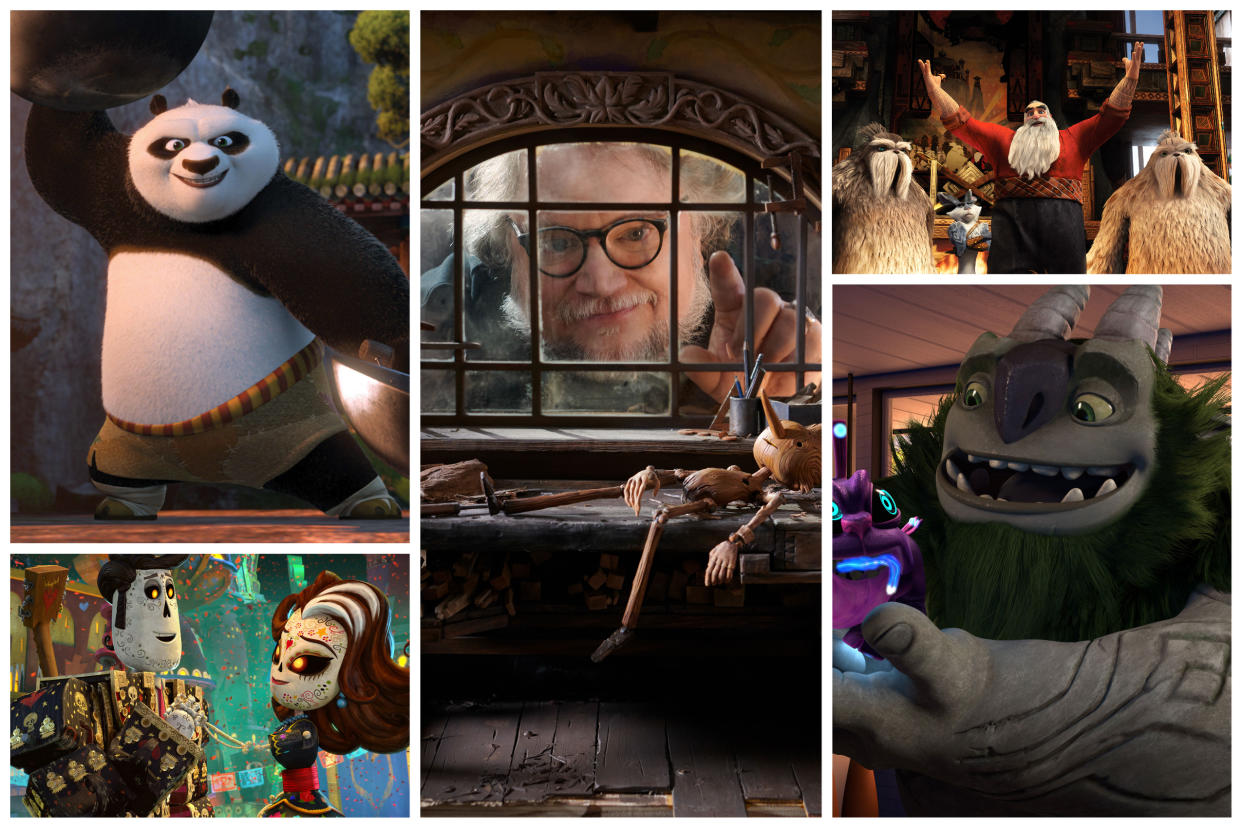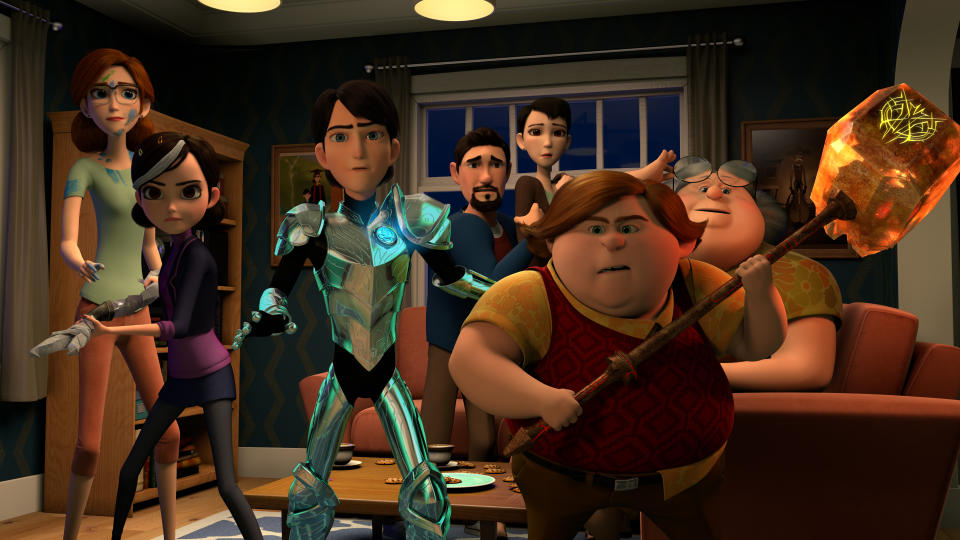Guillermo del Toro Has Always Been a Champion of Animation

- Oops!Something went wrong.Please try again later.
- Oops!Something went wrong.Please try again later.
- Oops!Something went wrong.Please try again later.
- Oops!Something went wrong.Please try again later.
- Oops!Something went wrong.Please try again later.
During Guillermo del Toro’s time as an animation producer at DreamWorks, he earned a certain reputation around the studio. “Jeffrey Katzenberg called me ‘The Harbinger of Death’ because a lot of my solutions to a character conflict was to kill them.” del Toro recalled, with a laugh, during a recent interview with IndieWire. It was the early 2010s, when DreamWorks movies were starting to become darker and more daring, and del Toro wanted to push directors to try riskier, wilder things. “When I consulted on ‘How to Train Your Dragon’ they were debating what to do with the father character,” del Toro explained. “I said, ‘Kill him. That will give the entire movie a lot more gravitas.’” Likewise, “Puss in Boots” offed its villain, one of the heroes died halfway through “Rise of the Guardians”, and “Kung Fu Panda” included a panda massacre as a plot line.
“The first big thing he did was helping with a big restructure of the movie,” “Rise of the Guardians” director Peter Ramsey said. “He sort of reminded us that it’s a movie, not just a collection of sequences and scenes, which you can sometimes get caught up in when doing animation.”
More from IndieWire
What Does 'Pinocchio' Have in Common with 'The Godfather'? It's All in the Lighting
'Marcel the Shell': Behind the Stop-Motion Crowd-Pleaser's Quest to Make Oscar History
Del Toro once planned to make his first feature in stop-motion; at DreamWorks, he set out to learn every aspect of animation. “I produce to learn, and I’m not being facetious,” he said. The newly released “Guillermo del Toro’s Pinocchio” may be the first time he’s been able to put that learning into practice on a film that he directed, but as a number of animators told IndieWire, it’s far from the first animated film to benefit from the input of the Oscar winner and tireless animation advocate.
“The Book of Life” director Jorge R. Gutiérrez, describes del Toro’s multitasking skills as superheroic. “He literally has a cabinet of curiosities in his head, and he’s able to close all the things and open the one he’s working on with you and remember every version of it.” Gutiérrez recounted a time when he spent a half hour pitching “The Book of Life,” beginning to end, to del Toro, who then proceeded to suggest some changes by reciting the entire pitch word for word, restructuring, and tweaking on the fly. “I’ve never witnessed anything like that. It’s like I saw Maradona score the best goal in the World Cup in front of me.”
According to his collaborators, del Toro’s role as a producer of animation was twofold — that of a mentor, and that of a champion. “He was very generous about spending his time just talking about life, about the process and the lonely job of directing,” said “Kung Fu Panda 2” director Jennifer Yuh Nelson. “He understood the struggle and had a great way of telling you when you needed to get tougher or be more flexible.” Aaron Waltke, co-showrunner of “Wizards: Tales of Arcadia,” remembered del Toro shielding the show from outside pressures. “He did everything he could to basically keep the studios and the powers that be at bay and just let us do our work. He’d essentially say, ‘Leave the writers alone, and it will pay dividends.’ That’s the kind of producer you want in your corner.”
“I like very much creating protective structures for other creators,” del Toro said. He radiates a joy when praising his collaborators calling Nelson “extraordinary at staging action,” and Peter Ramsey “just a master storyteller” for the way he pushed for naturalistic acting in his characters. On Gutiérrez: “Jorge is a nuclear reactor of creativity, so I mostly acted as a structure that protected the core of that reactor.”
For his part, Gutiérrez recalled how, initially, he’d always agree with the notes given by del Toro, and often said yes to the studio’s notes to avoid a fight. But when he finally said no to a big note from his producer, “his smile got so big and he went, ‘Gordo, did you hear that? That was your testicles dropping. You’re finally a man! From now on, always speak up, to me and to everyone.'”

Netflix
Prior to “Pinocchio,” del Toro helmed the premiere of Netflix’s “Trollhunters: Tales of Arcadia.” The show, part of an expanded animated universe comprising three series and a movie, saw the filmmaker finally move from producing other people’s animated stories to creating his own. Still, if you ask him, he’d say “Tales of Arcadia” wasn’t really his, not in the way his latest film is. “‘Pinocchio’ is as personal and belongs in the same place as ‘Devil’s Backbone’ and ‘Pan’s Labyrinth,’ and has a lot more of my point of view,” del Toro said. By contrast, “‘Trollhunters’ is something I wanted to create, but collectively.”
“He really gave everyone on the team ownership of the show,” said co-director and showrunner Rodrigo Blaas. “We all checked our egos at the door, but having said that, everything still goes through the filter of Guillermo’s imagination, so it definitely feels like his vision all the way through.” Waltke, also worked on “Wizards,” agreed that it could have been easy for a big-name producer like del Toro to just force his vision on everyone, given that he created the world of the show, “but Guillermo was never like that.” “Still, I think we deep down just wanted to make Guillermo proud of what we were accomplishing together, he’s the type of person you want to impress,” Waltke said.
In some ways, “Trollhunters” paved the way for “Pinocchio” to unleash del Toro’s animated vision: Not only did the show establish a partnership between the filmmaker and Netflix that led to a deal in 2020, but it also established one major del Toro signature that carried over to his feature animation debut — mistakes. For the producer and director, adding unnecessary moves to character animation makes it feel more alive and less driven by pantomime, a tenet of his approach to “Pinocchio.”
“We bonded over the idea that having human mistakes would give the characters a layer of credibility,” Blaas explained. “It’d be in small moments, which you don’t necessarily notice, but add so much. Like Toby struggling to close a microwave and having to try again and really push it hard. It makes a drawing appear more human.”
Del Toro has always been interested in animation and in uplifting new voices; while his experience with “Pinocchio” has made the director consider making more in the medium, he is also looking to continue producing and helping the next generation. He used the opportunity of his Oscar win for “The Shape of Water” to create two filmmaking scholarships — including one in animation — as well as creating the Guadalajara International Animation Center (unofficially known as “El Taller del Chucho”), which specializes in stop-motion. “I think it’s very important to showcase and protect whoever is coming after,” he said. Together with “Pinocchio” studio Shadow Machine, the workshop space was designed to be able to stand side by side with any other production company in the world, and used “Pinocchio” as an opportunity to showcase the young animators’ talents.
That the workshop specializes in stop-motion isn’t just because “stop-motion is the only animation technique that I fell head over heels for and tends to attract weirdness in a weird way,” as the filmmaker explained. There’s a practical motivation: longevity. “It’s the only technique that a young animator can do with very few resources on their own,” he said. In Latin America, cinema tends to be closely tied to government financing, and the tools needed to make animation are not of the caliber of those used by DreamWorks or Pixar. “But if you wanna compete in stop-motion, you need lights, artistry, and a camera, that’s it,” del Toro said. “It’s a really great tool to foster individual expression in animation.”
Best of IndieWire
New Movies: Release Calendar for December 9, Plus Where to Watch the Latest Films
Guillermo del Toro's Favorite Movies: 45 Films the Director Wants You to See
Sign up for Indiewire's Newsletter. For the latest news, follow us on Facebook, Twitter, and Instagram.

